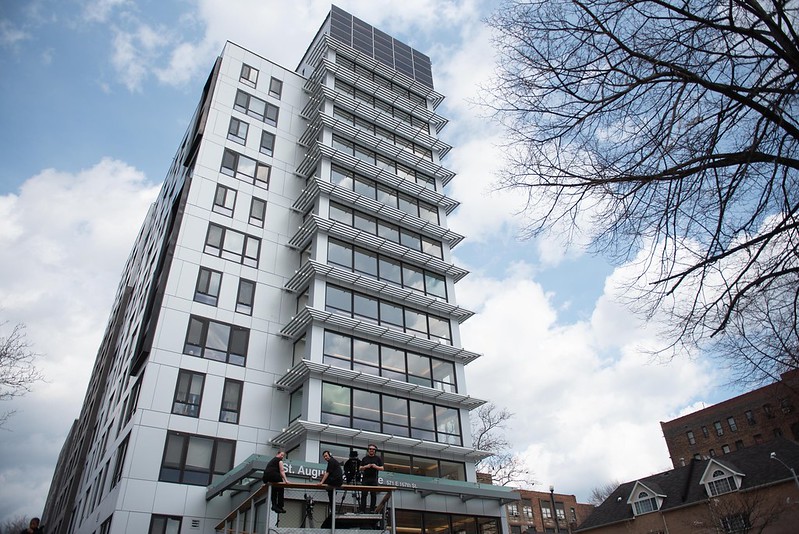New York Needs to Invest in the Catskills for the Good of the Whole State

The Catskills from above (photo: @CatskillCenter)
Albany’s budget is tough this year, with an unprecedented $6.1 billion gap to close. New York State has adopted the nation’s most ambitious climate change agenda, which will cost $33 billion over five years, and Governor Cuomo proposes keeping the State’s Environmental Protection Fund (EPF) at a record $300 million.
Environmental spending may seem like a luxury when budgets are tight, let alone unprecedented environmental spending. But doubling down on the state’s environmental agenda is the responsible choice—not a luxury.
This year’s EPF appropriations as outlined in the governor’s budget plan will fund climate change programs ($20 million), solid waste programs ($39 million), open space ($152 million), and parks and recreation ($89 million). It funds mitigating and adapting to climate change, stimulating renewable energy, protecting farmland, fighting invasive species, improving water quality, supporting tourism growth, and seeking environmental justice. These smart investments in our future also generate statewide economic development, sustainable growth, and fiscal returns.
State funding has helped ramp up Catskills tourism to 12 million visitors a year and counting (currently more than the Adirondacks and roughly twice the visitorship of the Grand Canyon). Last year Lonely Planet named the Catskills one of the Top 10 Best Regions for Travel.
Even with New York’s other world-class industries, as the state's third-largest employer, tourism is key. In the Catskills, tourism generates $1.3 billion a year in direct spending, $161 million in state and local taxes, and supports 18,500 jobs. These numbers are growing fast, with an 11.3% jump in 2019 Catskills tourism over 2018.
The Catskills are a unique part of the world: pristine forests, abundant wildlife, vital waterways, unique communities, and unparalleled recreational opportunities—all within an easy drive to New York City, which gets most of its drinking water, some of the nation's purest, from Catskills reservoirs.
Catskills public lands are managed both by the state Department of Environmental Conservation (DEC) and New York City’s Department of Environmental Protection, and receive no Parks Department funding. Like the rest of the world, our resources are threatened by climate change, development pressures, and other factors. Continued tourism growth, thriving communities, and environmental protection depend on state investment in the region.
Every year I help lead a coalition of several dozen local groups and volunteers to Albany for Catskill Park Day, where we make the case to state legislators and the governor’s office for directing funding to the Catskills. In 2015 we obtained $500,000 in the DEC’s “Aid to Localities” budget, which paid for new trails, access improvements, and parking areas. In 2016 the Assembly's budget included $4 million for the Catskills in the EPF, but it was zeroed out in the final budget negotiations. The next year, we secured over $15 million in state funding.
This year, we asked Governor Cuomo to increase the overall EPF and allocate $15 million in his budget to manage and grow Catskills tourism through infrastructure improvements, fund the Catskill Visitor Center, install renewables in the region, conduct local research on invasives and Lyme disease, and support economic development of Catskills towns.
Although the governor understands the need to invest in the region, and included some of the coalition's requests in his executive budget for next fiscal year (FY2021), this legislative session will be the acid test of whether this kind of spending can survive the budget process.
Some will ask if we can afford to invest in the Catskills given the $6.1 billion gap. But the region is a key environmental resource, an integral part of the fight against climate change, an engine of tourism and upstate economic growth, and contributes to what makes New York unique. The question ought to be, can we afford not to?
***
Jeff Senterman is the Executive Director of the Catskill Center. On Twitter @JeffSenterman & @CatskillCenter.
***
Have an op-ed idea or submission for Gotham Gazette? Email This email address is being protected from spambots. You need JavaScript enabled to view it.
To Protect New Yorkers’ Health, New Patient Protection Laws Must be Enforced

(photo: Governor's Office)
When it comes to determining the proper course of care for a serious health issue, decisions should be made by a patient and their health care provider. But too often, health insurers have been undermining providers’ decisions in efforts to cut costs — forcing them to navigate burdensome bureaucratic roadblocks before agreeing to cover prescribed treatments and services. That can result in patients facing delays in care or going untreated altogether.
To address this problem, New York lawmakers recently worked to protect patients by requiring health plans to ensure timely access to care. Unfortunately, new findings suggest that these new requirements are frequently not being met, and it should be the priority of patients, health care providers, and advocates throughout New York to ensure that these new laws are being enforced.
With health care costs continuing to spiral, many health insurers have explored ways to rein in spending. Policies such as prior authorization, which requires health care providers to receive approval from an insurer before prescribing a costly treatment or service, or step therapy, which requires patients to try and fail on alternative, typically older medications before moving on to newer and sometimes costlier treatments, have become widely integrated among health insurance plans in recent years.
However, these policies often end up creating unnecessary burdens by delaying treatment and undermining what practitioners deem to be the most effective course of care. Providers have long complained that prior authorization requests can often take anywhere from a few hours to a few weeks to be approved — or worse yet, denied — leaving patients without necessary care during this lengthy and frustrating process.
In fact, a 2018 survey from the American Medical Association found more than one in four physicians reported that these cumbersome requirements “led to a serious adverse event” for patients under their care.
New York lawmakers took action in recent years to strengthen patient protections, passing a pair of bills that would increase efficiency with prior authorization and grant more timely exceptions to step therapy requests. For example, under the new laws, health insurers must now respond to prior authorization requests in 72 hours for routine care and 24 for urgent situations. Similarly, patients can receive an exception to step therapy protocols if the plan’s required treatment is expected to be ineffective or the patient already tried and failed on the required treatment.
But many providers have come forward to express concerns that health insurers are not abiding by these new requirements. According to a recent survey of New York providers, for example, just 30 percent say that health plans are meeting these approval request times “every time,” and 33 percent say that the paperwork process has not been simplified or see no difference.
Meanwhile, more than 79 percent of providers say that the changes in step therapy laws either have made the process to request an exception more difficult or have not made a difference. Worse, given their frustrations, many providers do not seek to appeal the denial and instead will simply prescribe another medication — which may not be as effective as the originally prescribed treatment.
While health plans are still adjusting to these new regulations, these findings suggest there is significant room for improvement when it comes to increasing access to care. Physicians and patients should go through the appeals process to petition insurers for their treatments and file complaints for egregious behavior. At the same time, lawmakers and regulatory agencies can take a more proactive approach to ensuring that these policies are being enforced appropriately, including collecting data from insurers to measure compliance.
The passage of these bills was a landmark moment for patients, providers, and advocates throughout New York in guaranteeing better access to health care. Now, they must make their voices heard to state lawmakers and regulators in order to ensure that they are able to realize the promise that these bills once held.
***
Stacey Worthy is a staff attorney for Aimed Alliance, a non-profit health policy organization that seeks to protect and enhance the rights of health care consumers and providers.
***
Have an op-ed idea or submission for Gotham Gazette? Email This email address is being protected from spambots. You need JavaScript enabled to view it.
Why We Need a Comprehensive City Plan Now

(photo: Michael Appleton/Mayoral Photography Office)
New York City’s housing crisis is getting worse. While a significant number of luxury units sit vacant, the population of homeless children is growing, we have only a 1% vacancy rate in public housing, and more than half of New Yorkers spend over a third of their income on housing. We have a serious problem on our hands.
According to basic economics, the solution to demand exceeding supply is an increase in supply. A scarcity of units causes prices to rise; the most effective way to ease this upward pressure on rents is to build more, and to do so quickly. New residential units start a “migration chain” that filters down to lower income brackets, as well; the benefits of new construction filter down the property ladder even if the new construction is a luxury high-rise. Development alone is not enough -- we need to incentivize the creation of affordable units and provide low-income families with additional assistance -- but unless we build more, we have no hope of making housing more affordable in New York City.
And yet, we are struggling to build. According to Mayor de Blasio’s “Where We Live Now” plan, there were 163,000 new housing units built in the 2010s, down from 198,000 the decade before. Even the 1930s saw greater production of new housing.
Though conceptually, most people would agree that to fix our shortage we need to build new units, in reality most people don’t want new construction on their streets. Resistance to new development comes from a variety of different fears. Though blocked views, loud construction, and overcrowded trains are easy to dismiss as NIMBYism, other concerns are more nuanced. New development can change neighborhood character, and many communities fear that it can accelerate gentrification and displacement (though research contradicts this claim).
Despite these objections, we need to build more housing. Currently, it seems like any proposal, no matter how small, encounters fierce opposition. We should be mindful of how development will impact our diverse neighborhoods, but protestors and anti-development activists should consider the counter-factual: What will happen to our city if there is no development at all?
The build-but-not-here phenomenon we are experiencing in New York City is a classic collective action problem. In many cases, it is rational for people to want to keep new construction out of their neighborhoods. But when we take an individual’s rational decision and expand it to an entire city, we run into trouble. When all of New York City says “no” to new development, where does that leave us?
Currently, development proposals feel haphazard and uncoordinated, but we can start to break the stalemate with a comprehensive city plan, which is in the City Council’s legislative pipeline. Led by Council Speaker Corey Johnson and Council Members Brad Lander and Antonio Reynoso, the comprehensive plan would sketch out a long-term plan for rezoning, development, and land use decisions within the five boroughs.
The New York City Council attempted to introduce a comprehensive city plan as part of the 2019 Charter Revision Commission. The 2019 proposal, which failed to be put to voters, observed that for other major cities across the globe, comprehensive plans serve “as the basis for land use, zoning, and capital planning decisions.” New York City struggles to reach consensus on any of these issues, leading to stalled projects and, ultimately, skyrocketing rents.
Critics of a comprehensive city plan decry it as a toothless document and futile effort. They compare it to existing “fair share criteria,” a set of guidelines to help New York City place public facilities in a thoughtful, equitable way. Though well-intentioned, the criteria have made little difference in how city government actually allocates facilities.
Whether or not a comprehensive city plan changes patterns of development in New York City, though, at the very least such a plan will make new development projects feel more coherent. Currently, New Yorkers struggle to see how the buildings proposed for their neighborhoods fit into a broader effort to make housing more affordable. When proposals feel like one-off projects, they are easy to dismiss. After all, it is true that one building will not make a meaningful difference to the number of units we have on the market.
If, however, each proposed building is part of a clear plan to make New York City more affordable for everyone, opposition to development may become less venomous. True, a comprehensive city plan will not solve our housing affordability issues or eliminate disagreement entirely. Tensions surrounding gentrification and displacement will remain, and NIMBYism will continue. But at the very least, New Yorkers will be able to see how each new development connects to a larger plan. A citywide planning framework will not fix everything, but it is a good place to start.
***
Benjamin Heller is a graduate student at NYU’s Robert F Wagner School of Public Service. On Twitter @BenjaminHeller0.
***
Have an op-ed idea or submission for Gotham Gazette? Email This email address is being protected from spambots. You need JavaScript enabled to view it.




